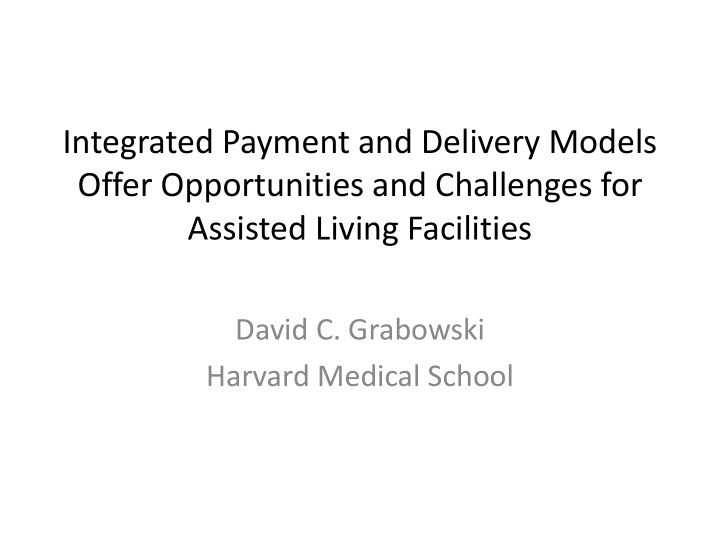



Integrated Payment and Delivery Models Offer Opportunities and Challenges for Assisted Living Facilities David C. Grabowski Harvard Medical School
Objectives • Review Health Affairs study: what do the data suggest are the opportunities/challenges to coordinating care? • Stakeholder interviews: what do industry leaders see as opportunities/challenges to coordinating care? • Where do we go from here?
Objectives • Review Health Affairs study: what do the data suggest are the opportunities/challenges to coordinating care? • Stakeholder interviews: what do industry leaders see as opportunities/challenges to coordinating care? • Where do we go from here?
Health Affairs Study
Research Questions • How does the presence of chronic illness compare across community, ALFs, and nursing home populations? • What is the rate of hospitalization and SNF use for ALF residents relative to similar individuals in community and nursing home? • What is the current capacity for care coordination in the assisted living sector?
The Residents “ Years ago, the ideal assisted living resident was Miss Daisy -- lucid and opinionated, didn’t need extensive nursing or personal care, just transportation, light housekeeping and meals, and the attention of the courtly Morgan Freeman.” Span, 2011 H/T Sheryl Zimmerman, UNC
Health Affairs Paper: Key Takeaways • ALF residents have intensive care needs • ALF residents use lots of Medicare services • ALFs have some clinical “infrastructure” but have generally not invested in the coordination health and LTC services • Lots of care coordination efforts under the ACA directed at community and nursing home LTC populations, why not the assisted living population???
Objectives • Review Health Affairs study: what do the data suggest are the opportunities/challenges to coordinating care? • Stakeholder interviews: what do industry leaders see as opportunities/challenges to coordinating care? • Where do we go from here?
Stakeholder Interviews • Detailed interviews with leadership at 6 senior living companies and three health care REITs • What is happening now around care integration and what do they envision happening in the future?
1) No company had yet to join an ACO or other global payment model under the ACA • Hospital systems still “feeling their way” with ACO model • Much discussion around these models but no contracts to date • Several termed these relationships “inevitable”
2) Much heterogeneity in use of payment/ delivery models across companies • Some actively positioning themselves to be a part of global payment/delivery systems, while others are more focused on housing/hospitality services • One company has highly integrated onsite medical care delivery & their own Medicare Advantage (MA) plan • Another company developed a medical model focusing on preventive geriatrics, skilled nursing and care transitions
3) Enthusiasm for new population- and episode- based models • Population-based models : E.g., At-risk ACO models that encompass senior living populations • Episode-based models : E.g., Senior living communities could partner with bundled payment demos to provide lower cost short- term rehab
4) Regulations are an important barrier to innovation • Regulations vary considerably by state • In certain states, the ability of senior living to deliver health care services very limited • Role of regulation in quality improvement also quite variable by state (“extremely unregulated” relative to SNFs)
5) IT and Data Capabilities Underdeveloped H/T Lindsay Schwartz, AHCA/NCAL
5) IT and Data Capabilities Underdeveloped • No company that we spoke to had integrated their health records with that of a hospital/MD network • Most companies do not track health care utilization in their communities • Difficult to enter into risk-bearing relationships without knowing baseline rates! • Most companies beginning to invest in IT/data capabilities
6) Much innovation at delivery-level • INTERACT • On-site medical care • Telemedicine • Case management • Etc.
Objectives • Review Health Affairs study: what do the data suggest are the opportunities/challenges to coordinating care? • Stakeholder interviews: what do industry leaders see as opportunities/challenges to coordinating care? • Where do we go from here?
Prediction is very difficult, especially about the future - Niels Bohr, Physicist
1 ) Care integration will entail… • Regulatory reform • Greater licensure standards across states • Investment in data infrastructure – Electronic health records – Quality measurement • Innovation around delivery level interventions
2) Bifurcation of Sector Some providers will emphasize integrated care models, others will emphasize housing – Challenge for Integrated ALFs: Avoid “medicalization” of ALF care, nobody wants “Nursing Home Light” – Challenge for Housing oriented ALFs: How to offer services such that individuals can age in place – Goal is to do both well!
Concluding Thoughts • Overall, senior living is a “success story” in our LTC system: – Providers: Tremendous growth – Residents: Age in place, hopefully delay (avoid!) nursing home care – Government: Largely private-pay • Given clinical needs and high Medicare costs of ALF population, integrated ALF models have great potential going forward
Recommend
More recommend